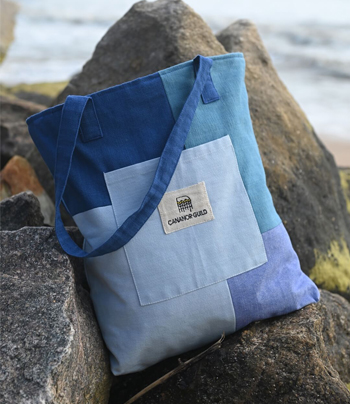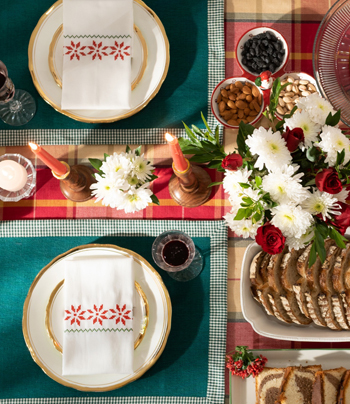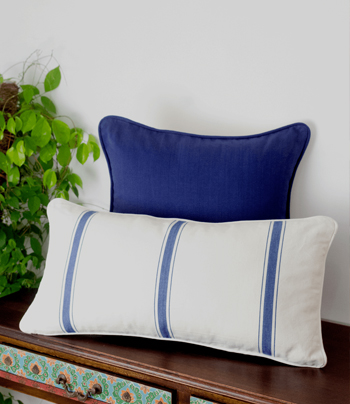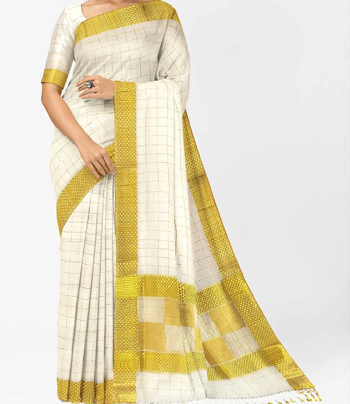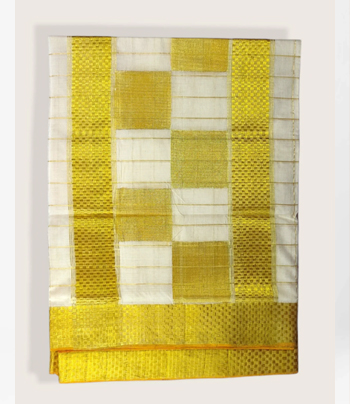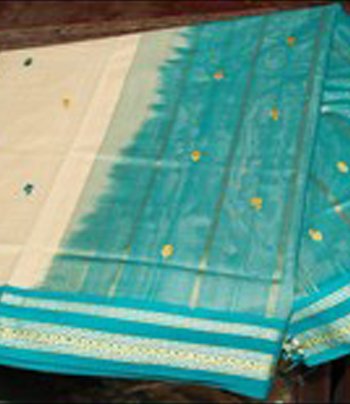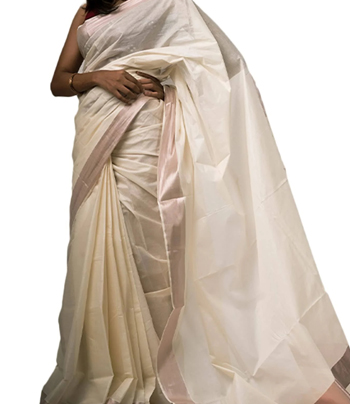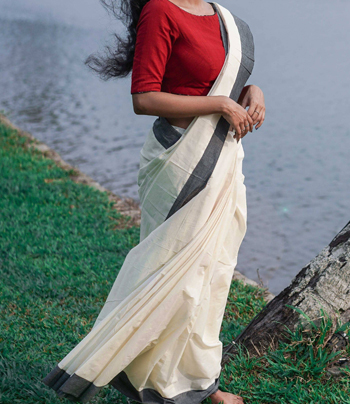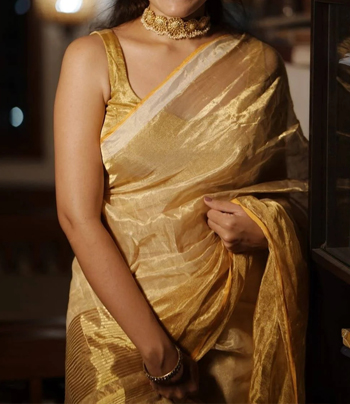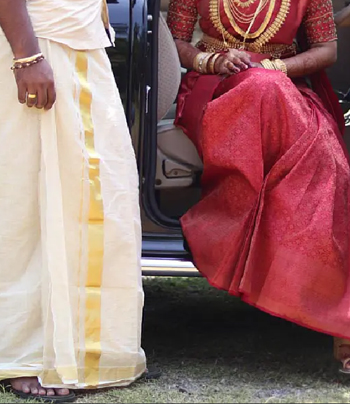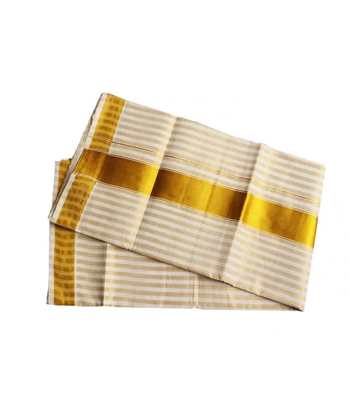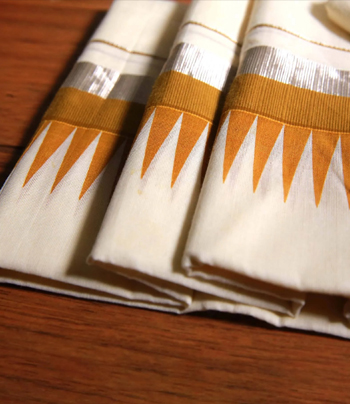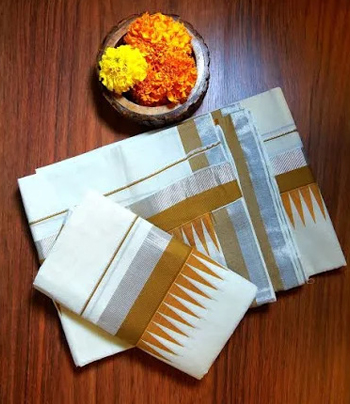Cannanore Home Furnishings
The Products from kannur has carved for itself the admiration of the niche markets and placed in the high end stores all around. They are distinctinctly recognizable due to the richness it carries and the feel of life in it. Furnishing fabrics include heavy figured and jacquard fabrics used for drapery and upholstery purposes. These furnishing fabrics are mainly woven on the fly shuttle frame looms in handloom. The fabric may be in stripes, checks, floral or geometrical designs, with woven borders, manufactured from cotton or art silk or in combinations. The another characteristic furnishing fabric called’ mushru’ cloth in satin weave, with silk or rayon warp and cotton weft, having brightly colored stripes and geometrical designs. Handloom damask is a firm lustrous reversible fabric where a weft satin is formed upon a warp satin ground or vice versa. Casements, in a variety of designs are also popular for furnishings and dress materials depending on the weight of the fabric and end uses. Hand looms produce a wide range of counter panes and bed covers in a range of weaves and designs. Woven in cotton, these bed coverings may be in stripes, checks, floral or geometric patterns or carry intricate jacquard and dobby designs, ethnic and traditional motifs. Towels are manufactured in different weaves, viz. plain honey comb, huck-a-back, terry pile etc. Of these varieties, dobby and jacquard terry towels are exported in substantial quantities. The terry wash cloth known as ‘bar mop’ which was developed for the US market in 1976 has been important item of hand loom export. Handloom also produces herring bone, terry, honey comb, huck-a-back, Diaper and dosuti. In honey comb weave, the threads form ridges and hollows give a cell like appearance to the texture. In dosutis, double ends and double picks are interlaced in plain weave. These varieties are usually produced on the fly shuttle pit looms in different sizes using different counts of yarns.
Balaramapuram Sarees And Fine Cotton Fabrics
The handloom weaving in Balaramapuram dates back to this era of the Travancore history (about 200 years ago) and is associated with the royal family of Travancore (or Thiruvithamkur in Malayalam). The then princely state of Travancore with its capital at Thiruvananthapuram (now known as Trivandrum or Thiruvananthapuram) comprised of most of the southern parts of the present Kerala and the modern Nagarcoil and Kanyakumari districts of Tamil Nadu. The major items manufactured from Balaramapuram are Grey Saree, Dhoti (also known as Veshti or Mundu), Set Mundu (Pudava & Kavani or Mumdum Neriyathum) and Ladies Dress Material (Punjabi Dress). These traditional products are woven with kora white cotton yarn (grey or unbleached or non-dyed yarn) of finer counts. The combination of Dhoti and shirt is the traditional outerwear of the adult male in Kerala. The traditional outerwear of the women folk is called Set mundu, a combination of Dhoti for covering the lower part of the body and Kavani (or Neriyathu) to wrap around the upper portion of the body like dupatta. Pudava and Kavani is the traditional wedding dress of the brides in the southern part of the state. The Set Mundu has been replaced with Grey Saree and Ladies Dress Material.
Kasaragod Sarees
The origin of the handloom weaving of Kasaragod sarees and other fabrics in the district trace back to 18th century AD. The history states that the weaving community, the Shaliya (or the Chaliya), has migrated from the East Karavali coast of the present Karnataka State en route Tamil Nadu.Handloom weaving, like the other clusters of Kerala, was a home based cottage industry in Kasaragod district also. This group of weavers already settled in the weaving clusters of Tamil Nadu left the place due to political, social and natural reasons and settled in Tulu Nadu of the South Canara region.The major items manufactured in the handloom sector in the Kasaragod cluster vary from products made out of fine cotton yarn to coarser yarn. Kasaragod Sarees (both Kasaragod Cotton Sarees and Kasaragod Art-silk Sarees) are the most famous hand-woven item produced here. The traditional Kasaragod Sarees are woven with coloured cotton yarn (dyed yarn) of finer counts or with coloured art-silk yarn. These Sarees are produced either with check design in the body with solid border or Plain Saree with Butta designs.
Kuthampully Sarees
The major items manufactured in Kuthampully are Grey Saree (Kuthampully Saree or Set Saree), these traditional products are woven with kora white cotton yarn (grey or unbleached or non-dyed yarn) of finer counts. The communities or castes in the present Kerala have diverse origins owing to various migrations and the later consolidation under a single identity. All weaver castes in Kerala have either Tamil/Telugu or Kannada origins. The Malayali collective identity for weavers in Kerala is Chaliyan. This may show that the majority of Malayali weavers belong to the Sale or Sali community of South India. The main weavers' castes of South India are Sale, Devanga and Kaikkolar. Among these the first two castes are native to Kannada and Telugu speaking regions by inscriptional evidence whereas Kaikkolar community is native to Tamil speaking region. It should be noted here that the earliest mention of Kaikkolar as weavers comes in an 8th century Jain lexicon, but weavers known as Kolika (a Prakrit word for weavers; Sanskrit: Kaulika) had their guilds during Satavahana period in Andhra region. One comes across weavers named Jeda (Kannada: spider or weaver), Jada, Sedan (Tamil) and Chetan (Malayalam) in various literature.
Chendamangalam Dhoties - Set Mundu
Chendamangalam Cluster, another centre of traditional handloom weaving, produces the traditional varieties of clothing, Dhoties and Set Mundu. The Set Mundu or Mundum Neriyathum is a combination of Mundu (or Dhoti) for covering the lower part of the body and Neriyathu to wrap around the upper portion of the body like a Dupatta over the blouse. The Set Mundu is the traditional clothing of women in Kerala and is the oldest remnant of Saree. The Set Mundu consists of two pieces of cloth, the Dhoti or Mundu and Neriyathu or Kavani. The history of Chendamangalam handloom is closely associated with the Feudal Family of Paliam, whose eldest male members, had been the Chief Ministers of the Rajas of Cochin and represented the Perumpatappu Swarupam. The handloom weavers of the village had been patronized by successive Paliyath Valiyachans, the head of the family. In the early days of its origin at Chendamangalam, the weaving of handloom clothes was mainly done for the members of the Paliam family. The women of this family used to show off their dignity in dressing by wearing the Puliyilakkara Neriyathu, Kasavu Dhoti, Kasavu Sarees and other varieties of Chendamangalam handloom products. It was due to the high degree of excellence in the dexterity of fabrics manufactured by the weavers at Chendamangalam.
Kuthampully Dhoties - Set Mundu
The major items manufactured in Kuthampully cluster are Set Mundu (Mundum Neriyathum or Mundu and Neriyathu or Pudava and Kavani), Double Dhoti (also known as Double Veshti or Double Mundu), Grey Saree (Kuthampully Saree or Set Saree) and Ladies Dress Material (Punjabi Dress or Salwar Kurta). These traditional products are woven with kora white cotton yarn (grey or unbleached or non-dyed yarn) of finer counts. The combination of Dhoti and Shirt is the traditional attire of the adult male in Kerala. The traditional attire of the women folk is Grey Saree or Set Mundu, which is a combination of Dhoti for covering the lower part of the body and Neriyathu to warp around the upper portion of the body like a Dupatta. The Set Mundu had been the traditional wedding dress of the Hindu brides in most part of the state. Though most of the younger generation now prefers to adorn Ladies Dress Material (of kora cloth) as the traditional wear, sizable women still prefer to wear Grey Saree or Set Mundu on special occasions. The other specially of the Kuthampully products is the Half fine zari and dyed yarns used to create geometric, floral and nature- inspired patterns between the extra weft in the cross border. The unique pattern of these set mundu lies in the weaving technique where the above designs in the cross border are created by using hand-lacing with jacquard design. Another cross border pattern is the use of half fine zari (golden colour) strips intermittently cut the dark coloured brocade in the cross border.

